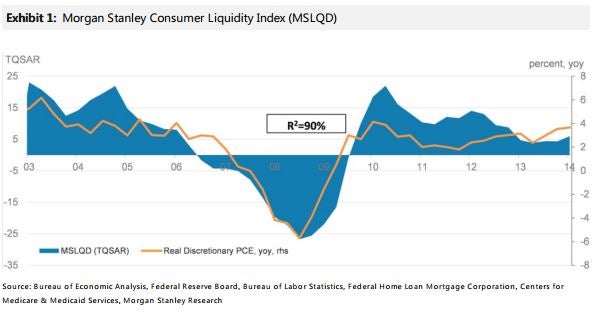In a recent report, analysts at Morgan Stanley gave their take on consumer spending trends and what they mean for the U.S. economy in 2015.
According to the most recent data, real discretionary personal consumption expenditure (PCE) increased to 3.7 percent in the fourth quarter, and analysts see strong evidence that the rise in spending will continue throughout 2015.
Consumer Liquidity Index
The Morgan Stanley Consumer Liquidity Index (MSLQD) spiked from 4.3 to 6.0 in Q4. This increase in spending marked the first significant quarterly rise in the index since 2012.

Analysts are able to use the MSLQD to forecast changes in PCE for the upcoming quarter. Using the most recent numbers, they see a PCE of 3.8 percent in 1Q15, slightly higher than the 4Q14 number.
Analysts note that consumer liquidity increased in 2014 in spite of the persisting tight credit environment. “Available credit continues to be a swing factor that can propel spending even higher as access to credit and willingness to use credit improves,” they explained.
Energy Consumption
Consumers dramatically increased their energy consumption in Q4. Gas prices fell by 30 percent last year, and the drop resulted in the highest number of highway miles traveled since 2007.
Which Sectors Benefit?
The sector with the highest income elasticity is motor vehicles and parts. Not surprisingly, that sector demonstrated robust growth in Q4 relative to its average quarterly growth.

However, other sectors with high income elasticity did not demonstrate above-average growth in the quarter.
Morgan Stanley analysts believe that these sectors, such as furnishings, financial services and transportation services, are likely to benefit from high consumer liquidity in upcoming quarters.
Although not specifically mentioned by the firm, the SPDR S&P Retail (ETF) XRT 0.06%, SPDR Series Trust XTN 0.09% and Vanguard Financials ETF VFH 0.39% could be worth watching. The trio was up an average of 3.8 percent over the past week.
Read this article and all my other articles for free on Benzinga by clicking here
Want to learn more about the stock market? Or maybe you just want to be able to look sophisticated in front of your coworkers when they ask you what you are reading on your Kindle, and you’d prefer to tell them “Oh, I’m just reading a book about stock market analysis,” rather than the usual “Oh, I’m just looking at pics of my ex-girlfriend on Facebook.” For these reasons and more, check out my book, Beating Wall Street with Common Sense. I don’t have a degree in finance; I have a degree in neuroscience. You don’t have to predict what stocks will do if you can predict what traders will do and be one step ahead of them. I made a 400% return in the stock market over five years using only basic principles of psychology and common sense. Beating Wall Street with Common Sense is now available on Amazon, and tradingcommonsense.com is always available on your local internet!

